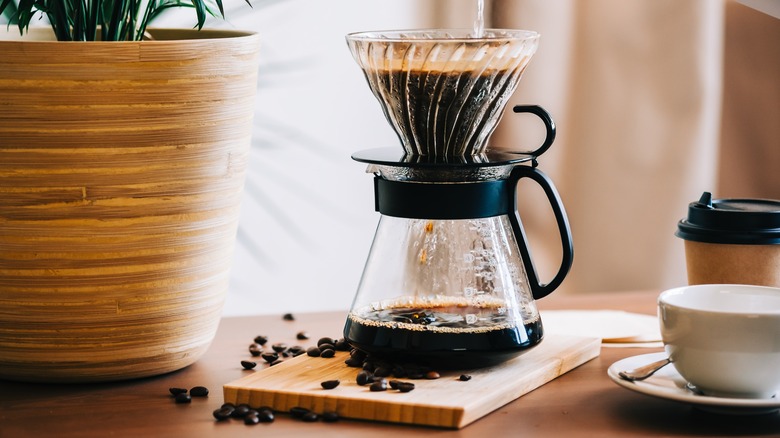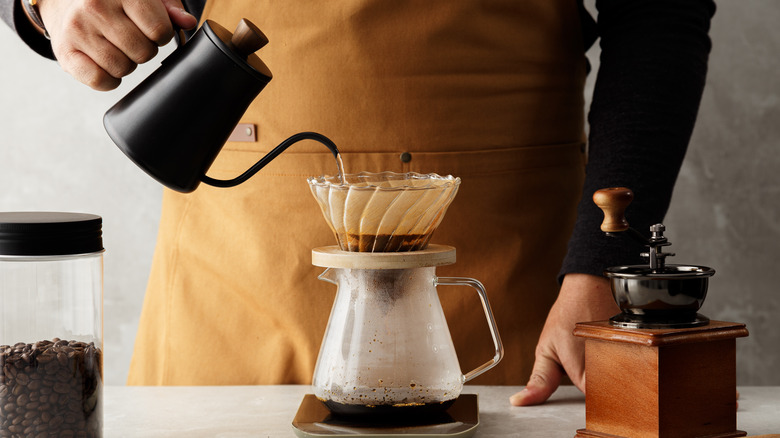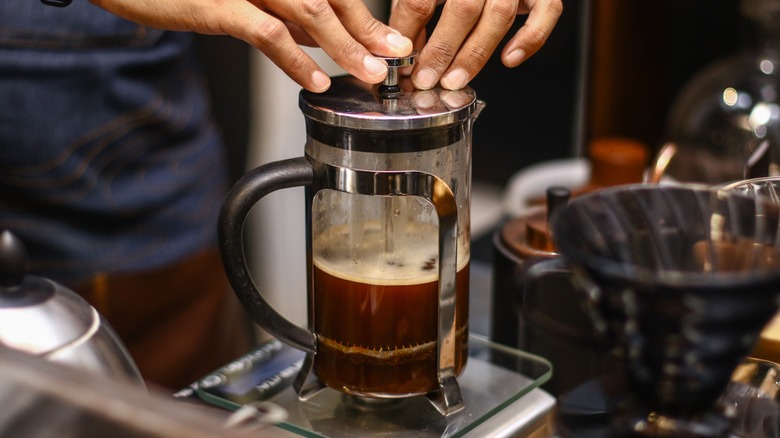The Differences Between Immersion And Drip Coffee Brewing Methods
Ever wondered why coffee from a French press tastes so different from a pour-over using the same batch of beans? It all comes down to how the brewing process exposes the coffee to hot water: Immersion brewing uses time and osmosis to extract the flavor compounds, while drip brewing uses gravity and motion to flush them out. While it might seem like the flavor makes it out to the brewed coffee all the same in the end, the "how" of the process ultimately defines what kind of flavor profile you're getting.
Immersion brewing gives the water enough time to sit with the coffee and extract everything, resulting in a strong, full-bodied flavor that also, unfortunately, lacks subtlety. Meanwhile, drip brewing takes all the flavor it can during the short contact and gets filtered through, resulting in a coffee with clarity and a much more detailed flavor profile. Generally, immersion brewing is a much more forgiving process that trades versatility for simplicity, whereas drip brews live and die by the little details. But neither method is necessarily better than the other, and you can even use them in combination to perfectly customize the taste of your coffee once you understand the key differences in how they work.
Drip brewing is all about timing and technique
In contrast to the slow and thorough extraction of immersion brewing, drip brewing works by forcing hot water through the grounds via gravity, quickly dissolving and capturing flavor compounds on the way down. As it brews, the coffee is not only filtered by the paper filter but also a layer of coffee grounds — often called the coffee bed — resulting in a clarity of flavor that highlights otherwise unnoticeable details. It also gives you much more hands-on control over the process, opening up a lot of opportunities to really tailor your coffee to your own tastes.
However, this touch-and-go method of brewing is extremely sensitive to variables and can often result in patchy, inconsistent brews. There are a lot of elements and issues to look out for, including pour time, agitation, channeling, filter clogging, and more. It takes a lot of time, practice, and experimentation to nail down a consistent cup of coffee when drip-brewing at home. That's also why drip-brewing coffee machines will usually produce some of the most underwhelming cups of coffee you've ever tasted: You're getting none of the boldness of immersion coffee while sacrificing all of the control that comes with pour-over brewing.
Immersion brewing gives more consistent and full flavor
Immersion brewing, on the other hand, is quite simple: You add the hot water to the ground coffee, wait a few minutes, then decant the coffee through a strainer or filter. The only variables you're controlling are the brew time, ground coarseness, water temperature, and water-to-coffee ratio, making it an extremely consistent and reliable method of brewing a strong cup of coffee. However, this consistency also means that there's far less you can do in the way of customization or fine-tuning the brewing process. The bold and thoroughly extracted flavor also means that the coffee loses the subtler notes in its profile, and even diluting it like a homemade americano doesn't do much to restore the lighter aromas.
Still, there's more to immersion brewing these days than just using a French press: Hybrid drip-immersion brewers like the Hario Switch or BonaVita involve the full extraction of immersion while adding a touch of clarity by dropping the coffee through a filter after brewing. If you have the budget, space, and time to do so, you could also invest in a vac-pot siphon brewer. As one of the most complex methods of manual coffee brewing, siphon brewers combine the consistency of immersion brewing with the freedom to control the finer aspects of your coffee.


